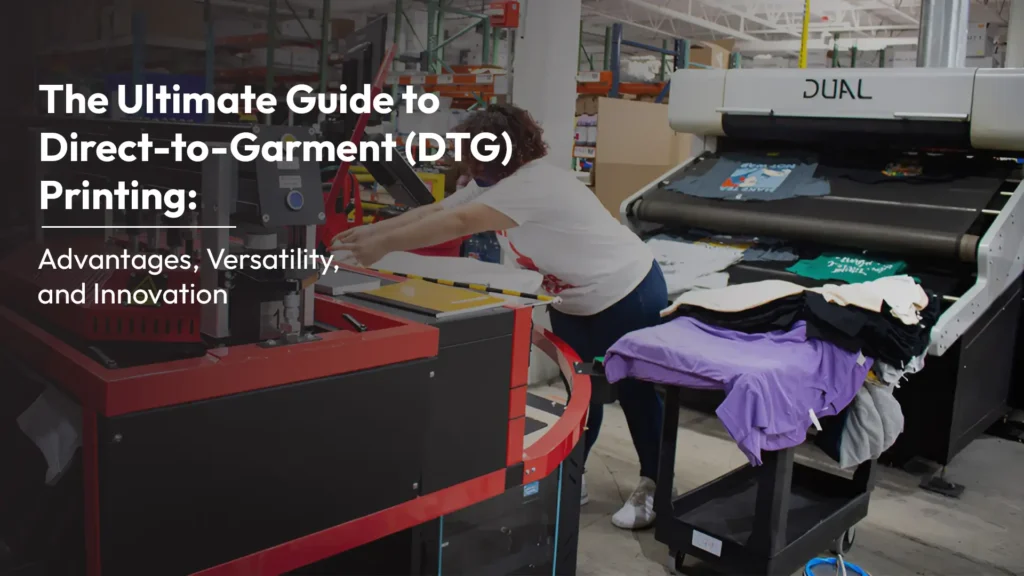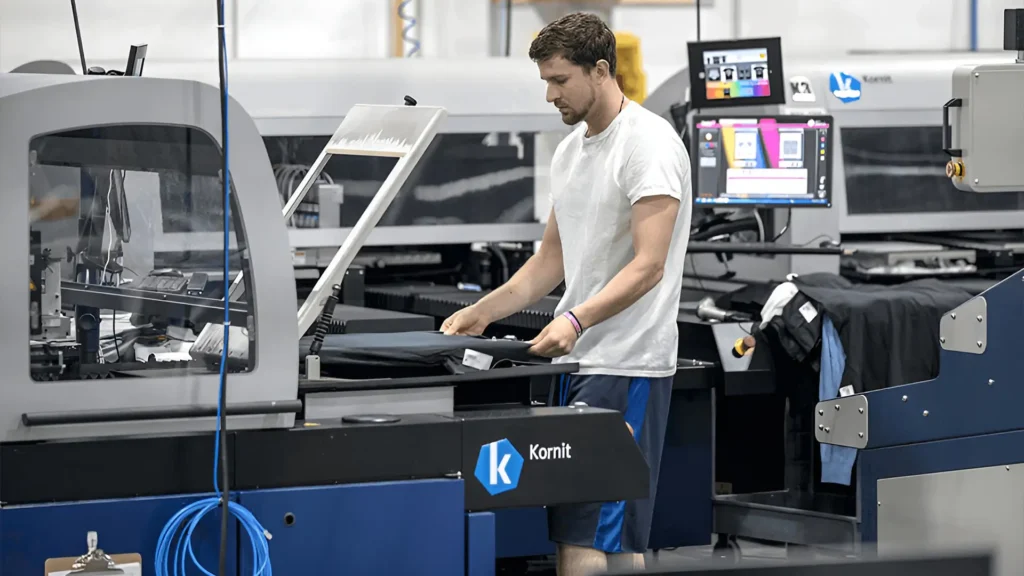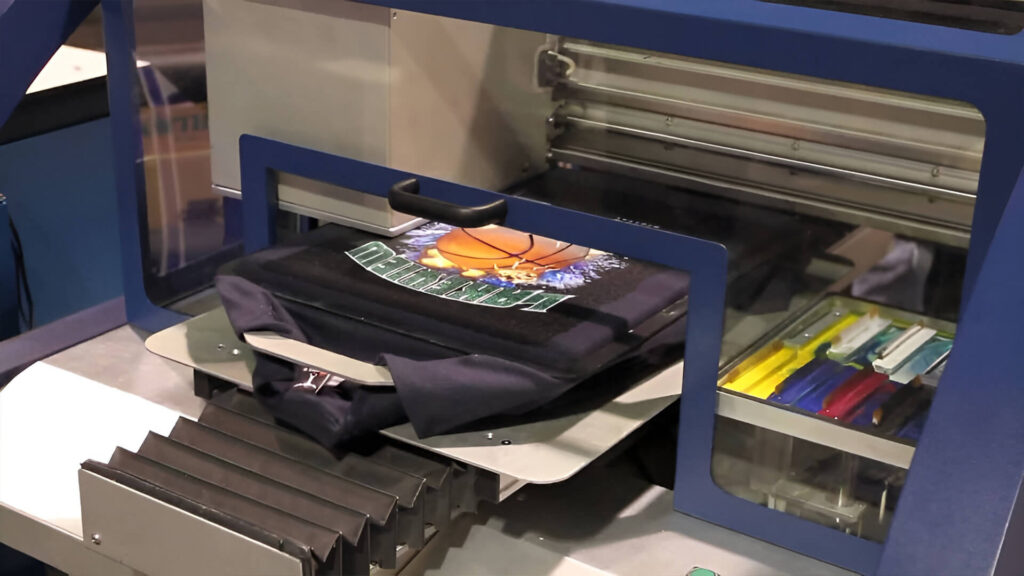Blog
Direct-to-Garment (DTG) Printing: Advantages, Versatility, and Innovation
- June 10, 2024

The DTG Printing Process
-
Design Creation:
Digital designs are created using graphic design software such as Photoshop or Illustrator. The designs are then saved in formats like JPEG, PNG, or TIFF.
-
Garment Preparation:
Before printing, garments are often pre-treated with a special solution that enhances color vibrancy and ensures the ink adheres properly. This step is crucial for achieving long-lasting prints.
-
Printing:
The garment is loaded onto a printing platen, and an inkjet printer applies tiny droplets of ink directly onto the fabric. This method allows for detailed and colorful designs to be printed with precision.
-
Curing:
After printing, the garment is heat-pressed to cure the ink. This process ensures that the print is durable and can withstand regular washing without fading or cracking.

DTG Printing Machines and Equipment
-
Entry-Level Machines:
Ideal for small businesses and beginners, these printers are cost-effective and offer good-quality prints. Examples include the Epson SureColor F2100 and the Brother GTX Pro.
-
Mid-Level Machines:
These printers provide faster turnaround times and a wider color range, making them suitable for medium-sized businesses. Examples include the Anajet mPower and the M2 from ColDesi.
-
Industrial Machines:
Designed for high-volume production, these printers deliver top-quality prints at high speeds. They are perfect for large businesses and include models like the Kornit Avalanche HD6 and Epson F3070.

Advantages of Direct-to-Garment Printing
High-Quality Prints
DTG printing produces sharp, detailed images with vibrant colors, making it ideal for complex and intricate designs. The precision and quality of DTG prints are unmatched by traditional methods, allowing for stunning visual effects and a professional finish.
Versatility
One of the greatest advantages of DTG printing is its versatility. It can print on a variety of fabrics, including cotton, polyester, and blends. This flexibility makes it suitable for a wide range of garments, from T-shirts and hoodies to sportswear and more.
Customization
DTG printing excels in customization, making it perfect for small orders and one-off designs. There is no need for screens or plates, allowing for quick changes and adjustments to designs. This makes it an excellent choice for personalized apparel and limited-edition runs.
Fast Turnaround
With minimal setup time required, DTG printing offers faster turnaround times compared to traditional printing methods. This efficiency is particularly beneficial for small businesses and individuals looking to fulfill orders quickly without compromising on quality.
Eco-Friendly
DTG printing uses water-based inks that are more environmentally friendly than traditional plastisol inks used in screen printing. These inks are designed to adhere well to fabric and are cured using heat, ensuring that the prints are durable and long-lasting without harming the environment.
Detailed and Vibrant Designs
The advanced inkjet technology used in DTG printing allows for a broad spectrum of colors, enabling the creation of complex, multi-colored designs without additional cost or effort. This capability is perfect for achieving vibrant, eye-catching prints that stand out.
Suitable for High-Quality Materials
DTG printing works exceptionally well on high-quality, 100% cotton garments. Cotton absorbs the water-based inks effectively, resulting in bright and durable prints. This makes DTG an ideal choice for premium custom apparel.
Small to Medium Runs
DTG printing is highly effective for small to medium production runs. The low setup cost and quick processing time make it a cost-effective solution for businesses and individuals who do not require large quantities of printed items.
No Minimum Order Requirements
Unlike many traditional printing methods, DTG printing does not require a minimum order quantity. This feature is particularly advantageous for small businesses, start-ups, and individuals who need high-quality prints without committing to large orders.
Innovation and Technology
The continuous advancements in DTG technology have led to the development of high-performance printers that deliver exceptional print quality and consistency. This innovation ensures that DTG printing remains at the forefront of custom apparel decoration.

Cons of Direct-to-Garment Printing
Durability:
While DTG prints are durable, they may not last as long as screen prints, especially on dark fabrics. Proper care is essential to maintain print quality.
Cost:
The initial cost of DTG printers and inks is higher compared to other methods, making it a significant investment for businesses.
Speed:
For large orders, DTG printing is slower than screen printing, which can be a drawback for businesses needing quick turnaround times.
DTG Printing vs. Other Printing Methods
Direct-to-Garment (DTG) printing offers detailed design and vibrant colors compared to traditional methods like screen printing and sublimation. While screen printing is more cost-effective for large orders, DTG excels in customization and quick turnaround times for small batches and complex designs. DTG’s eco-friendly water-based inks also make it a more sustainable choice for custom apparel production.
DTG Printing vs. Screen Printing
-
Detail and Color Range:
DTG printing excels in producing detailed and colorful designs without the need for multiple screens, which is required in screen printing.
-
Setup and Turnaround:
DTG has minimal setup time, making it ideal for small batches. Screen printing, on the other hand, is more efficient for large orders due to its faster production speed.
-
Durability:
Screen prints are generally more durable and can withstand repeated washing better than DTG prints, especially on dark fabrics.
DTG Printing vs. Sublimation
Fabric Compatibility:
DTG printing works well on cotton and cotton-blend fabrics, while sublimation is best suited for polyester fabrics.
Design Complexity:
Both methods support complex designs, but sublimation excels in producing vibrant, all-over prints on light-colored fabrics.

Choosing the Best Direct-to-Garment Printing Companies
Quality:
Look for companies that offer high-resolution printing capabilities and use modern, well-maintained DTG printers.
Equipment:
Ensure the company uses advanced DTG printers and equipment to produce high-quality prints.
Customer Reviews:
Check online reviews to check the company’s reliability and service quality.
Eco-Friendliness:
Prefer companies that use eco-friendly inks and sustainable printing practices.
Best Quality Direct-to-Garment Printing
-
Materials:
-
Inks:
-
Design Resolution: